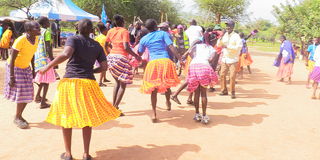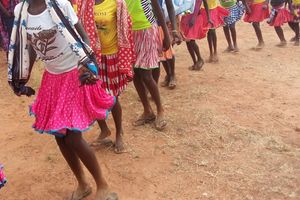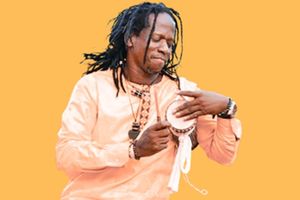
Women dancers on the arena during Kwara Kwara dance at Karon area in Kacheliba, West Pokot County on June 21, 2025.
Despite being outlawed, the popular local Kwara Kwara dance continues to take pastoral border areas in Kenya and Uganda by storm.
Originating six years ago from the Sebei community in Uganda and fused with Pokot cultural sounds, the dance remains a favorite among many music lovers across the region.
The dance is performed during ceremonies and parties, often at night and involves men and women moving in lines and circles.
Participants stomp the ground in rhythm while raising and lowering their hands in sync with their legs. The energy is infectious, with excited screams accompanying the music.
Men stride from leg to leg in imitation of cattle walking while women sway side to side in unison.

Women dancers on the arena during Kwara Kwara dance at Karon area in Kacheliba, West Pokot County on June 21, 2025.
In the dance, the women wear traditional pleated free-flowing skirts known as Lorwa with belts around their waists that emphasise their hip movements.
The dance often showcases femininity, with emphasis on expressive body movement. Men enhance their outfits with bead shackles for visual effect.
The dance has gained popularity in areas such as Alale, Kacheliba, Sigor, and Turkwel in West Pokot County and Amudat, Lokales, Karita, Nakapiripirit and Moroto in Uganda.
Two years ago, the Kwara Kwara dance was banned in West Pokot County by the government, citing its alleged contribution to prostitution and teenage pregnancies.
Last year, the dance often performed during harambees and social gatherings at night was also outlawed in Tiaty, Baringo County, for promoting immorality and contributing to broken families.
Claims of promiscuity
Despite the bans, the dance also known as Nasa or Kasauria continues to attract massive followings along the Kenya-Uganda border. In response to restrictions, performers have shifted to daytime dancing.
Kwa Kwara enthusiasts defend the dance arguing that it has been misunderstood and that it brings many positive benefits to the community.
Rael Chepkus, a dancer from Kacheliba in North Pokot sub-county said the dance contributes to good health.
“We love Kwara Kwara because of its beats. Dancing keeps us healthy as we don’t suffer from diseases like diabetes. It's fun to move to the rhythm,” she saidin an interview.
Ms Chepkus dismissed claims of promiscuity during the dance.
“It’s all about enjoyment and music and It's a form of physical exercise. Most of us are married and no one takes anyone's husband or wife. We perform it during women's fundraisers in public, usually around 6 pm then go home with our children,” he said.

Women dancers on the arena during Kwara Kwara dance at Karon area in Kacheliba, West Pokot County on June 21,2025.
Festus Toroitich, a resident of Kapenguria, said the dance also promotes peace in the region.
“Kwara Kwara encourages talent development in schools. We now have professional trainers earning from it. Learners even use it in competitions,” he said.
Chepket Chebet, another dancer from Kacheliba said the dance promotes Pokot culture and has no harmful impact on society.
“Kwara Kwara means celebration. It's also called Lopekirep and wee perform it at weddings, parties and during dowry payments,” she said.
Emily Rotito, another fan, said the dance stimulates the body and uplifts the spirit.

Women dancers on the arena during Kwara Kwara dance at Karon area in Kacheliba, West Pokot County on June 21,2025.
“It energises us and helps us forget our problems. Music is food for the soul and the dance is gradually replacing the traditional Kidong’a because the youth have embraced it,” she said.
She added that the dance reflects the region’s way of life, beliefs and emotions.
Many local musicians have capitalised on the dance’s popularity recording songs that incorporate Kwara Kwara rhythms.
Winny Angel, a musician from Kapenguria, said the dance promotes health and preserves Pokot culture.
“We introduced the dance to preserve our heritage. Our songs carry positive messages and the beats are even used in political music,” she said.







